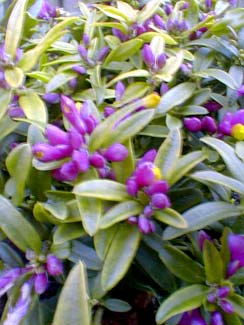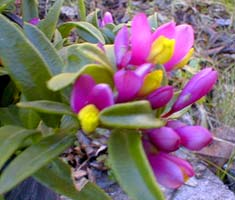
'Kamniski'
Creeping Milkwort; or,
Chapparal Pea
"Praise it is enough for me,
If there be but three or four
Who will love my little Flower."
-William Wordsworth
(1770-1850)
(1770-1850)
The flowers of Polygala chamaebuxus var grandiflora 'Kamniski' are profuse in late winter to very early spring, often but not invariably with rebloom in summer. The fragrance resembles candlewax, unusual yet pleasing. The flowers have deep impressively purple-pink wings, with yellow central petals, a mite larger than for the species. These winged blooms are said to resemble pea flowers, hence sometimes called the Chapparal Pea; but they about equally resemble miniature orchids.
Chapparel Pea is more widely the name of the actual legume family evergreen shrub Pickeringia montana. So the better name for polygana is Creepling Milkwort, sometimes called Shrubby Milkwort, & the genus name Polygala means "Lots of Milk." It does not have milky latex like a dandylion or a poppy, however, & gets this name for a more unusual reason.
 According to an old folk belief, cows that grazed on milkwort increased their milk production. It was also used as an herbal tonic by wetnurses hoping to double their milk production so that they could feed their own child as well as the child they were hired to nurse. Alas, the plant has no such ability.
According to an old folk belief, cows that grazed on milkwort increased their milk production. It was also used as an herbal tonic by wetnurses hoping to double their milk production so that they could feed their own child as well as the child they were hired to nurse. Alas, the plant has no such ability.Yet another name is Bastard Box or Box-leaf or Box-leaved Milkwort because of the leaves' resemblance to boxwood shrubs. It's a much more interesting shrub than boxes, however, since boxes lack the showy flowers. I think the dense mats of little leaves, as well as creeping habit, would have better justified common names referencing Vinca minor, so that Bastard Periwinkle would have been a more reasonable name.
'Kamniski' is an unusually robust clone developed from specimens collected in the Dolomite Mountains by Peter & Patricia Cox of Glendoick Nursery in Scotland. It blooms as early as January on Puget Sound, & certainly by February.
They are underutilized plants most likely because by the time most gardeners are making the nursery rounds to assess flowers after spring has sprung, the creeping milkwort is winding down its first flowering, so its greatest charms are difficult to present to the public in a timely manner. Yet for Pacific Northwest gardeners seeking a lively winter garden, such early flowering is a welcome boon.
A central European alpine evergreen, it weathers our mild winters without injury. It's a mat-forming groundcover that likes cool peaty conditions & can be beaten down by too hot a summer.
It does well in sun or bright shade, but where summers are long & dry, bright shade might be preferred, though if care is taken never to let it entirely dry out in summer, a sunny location should be fine. It is not seeking particularly wet soil, however, & needs ground that drains well. If it does get scruffy after a summer rebloom, it should be trimmed back a bit, then will freshen itself with new growth.
It is capable of humping up to ten inches tall, but ours is extremely flat to the ground, only two or three inches tall. It will slowly, slowly spread tino a two-foot carpet. Spread is so slow that it could be disappointing as a groundcover if planting tiny starts, but we sprang for a pair of three-gallon pots for a really good headstart on a patch of it along a path in front of a Rhododendron concinnum.
It is an easy plant in zones 6 through 8, but is only cold-hardy to about minus 5 degrees Fahreheit, & not at all heat hardy. So long as it receives its share of water, it is as suitable to the rockery or for containers. Slow-release evergreen fertilizer once a year is as much as it needs.